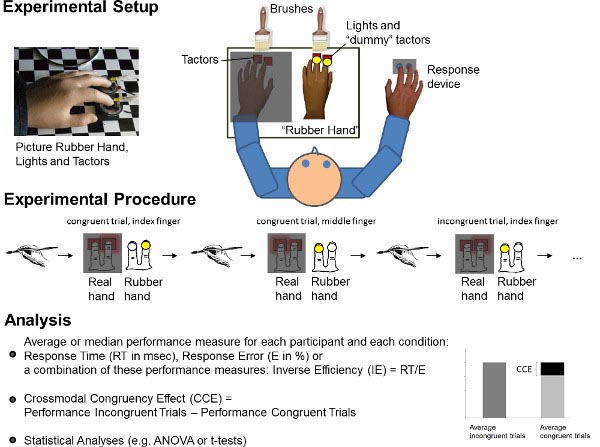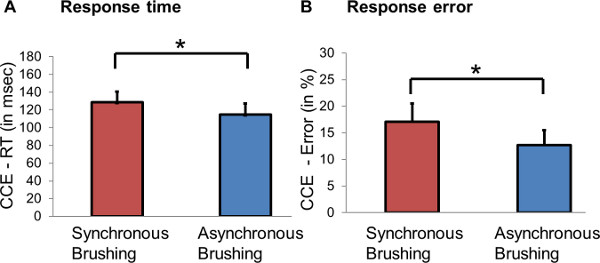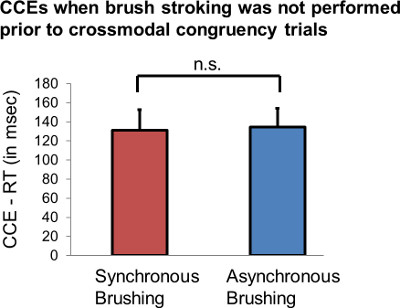The Crossmodal Congruency Task as a Means to Obtain an Objective Behavioral Measure in the Rubber Hand Illusion Paradigm
Instructor Prep
concepts
Student Protocol
1. Experimental Setup
- Material and Setup for the Rubber Hand Illusion Setup
- Use a box for the RHI paradigm which includes a cover for the participants own hand. Use a gown to also cover the shoulder and arm of the participant as well as the part of the rubber hand which goes up to the wrist.
- Obtain an artificial hand. This hand does not necessarily have to be made out of rubber (the name ‘rubber hand illusion’ was given because a rubber hand was used in seminal work 7). For example prostheses can be used.
- Use two soft brushes to deliver brush strokes in the RHI.
- Use a metronome, a pre-recorded sound file or experimental software to provide timing signals for the experimenter who delivers the brush strokes.
- Experimental Setup – Material and Setup for the Crossmodal Congruency Task
- For the crossmodal congruency task, use tactors to deliver tactile stimuli. For example small speakers, bone conductors (from hearing aids) or electromagnetic solenoid-type stimulators can be employed. Use ‘dummy tactors’ for the rubber hand.
- Control tactile stimulus delivery via the computer sound output, via an interface card or TTL pulses.
- Fix the position of the speakers in the box.
- Use for example light emitting diodes (LEDs) to deliver visual stimuli. These can be controlled with TTL pulses from a computer parallel card and powered for example using an USB port or batteries.
- Use experimental software to program stimulus presentation.
- Block any potential sound which could arise during the delivery of tactile stimuli. For example use headphones and white noise.
- Record responses for example using a response box, a computer mouse or a keyboard.
2. Participants
- All aspects of the experiment are in accord with the ethical standards laid down in the 1964 Declaration of Helsinki and have been approved by our local ethics committee (Macquarie University Human Research Ethics Committee, Australia).
- Obtain written informed consent for participation prior to the start of the experiment.
- Participants with visual or tactile deficits especially for the stimulated locations need to be excluded.
3. Experimental Procedure
- Ensure that participants are sitting in a comfortable position.
- Ensure participants can see the rubber hand and not their own hand.
- Include training blocks so participants become familiar with the crossmodal congruency task. Ideally first use practice trials without crossmodal visual stimuli in order to accustom participants to the tactile targets and then use practice trials with visual stimulus presentation and no-go trials (see below).
- On each crossmodal congruency trial present one tactile stimulus and one visual stimulus to one of the locations, either in spatially congruent locations (same fingers) or incongruent locations (different fingers).
- Instruct participants to respond and discriminate the location of the tactile targets as fast as and as accurately as possible.
- Locate a fixation point between the lights which participants should fixate throughout the experiment.
- Use no-go trials in order to ensure that participants are looking at the stimuli. For example ask participants to withhold their response if the lights in both locations turn on at the same time. When participants regularly press a button during these trials, then this can indicate that they are not looking at the lights.
- Use supra-threshold stimuli and make sure participants can see/feel the stimuli.
- Introduce a short delay (150-250 msec) between visuotactile crossmodal stimuli in order to reduce interference of these stimuli on the RHI itself.
- Include sufficient number of congruent and incongruent trials for each condition (about 60-100 trials).
- Present congruent and incongruent trials in different locations in a randomized sequence.
- Keep in mind that response requirements and mappings might affect the CCE magnitude 24.
- In order to induce the RHI use brush stroking for 1 to 3 min before the crossmodal congruency task and then stroke once before every crossmodal congruency trial.
- To induce the RHI illusion use synchronous brush stroking, where both hands should be touched at the same time and in the same location.
- Use asynchronous stroking as a control condition, where both hands should be stroked with a temporal offset.
- Make sure the experimenter can comfortably perform the stroking.
- You can also use RHI rating scales to monitor subjective experiences during the RHI paradigm. Some researcher suggest to use both objective and subjective measures for the rubber hand illusion paradigm for example 25. Obtain the rating responses after the task block if you would like to compare it to CCE effects because the task itself may modulate the RHI experience.
4. Data Analysis
- Trials in which participants responded too soon (e.g. faster than 200 msec after stimulus onset) or too slow (e.g. later than 1,500 msec) should be discarded from the analysis: check for potential significant differences between conditions for number of discarded trials.
- Analyze the number of false alarms in no-go trials: check for potential significant differences between conditions for number of false alarms.
- Obtain the average or median for performance measures (response time for speed and response error for accuracy) for each participant and each condition.
- Only use response times for correct trials.
- It is also possible to combine response time and error to a single measure: Inverse Efficiency (IE) = Response time/Error 17.
- Calculate and depict crossmodal congruency effects = performance on incongruent minus congruent trials for every trial and condition.
- Use statistical tests in order to assess the statistical significance of condition differences (e.g. ANOVA, t-tests).
The Crossmodal Congruency Task as a Means to Obtain an Objective Behavioral Measure in the Rubber Hand Illusion Paradigm
Learning Objectives
The magnitude of the CCE is significantly modulated in the RHI. In Figures 2 and 3 we present representative results from a previous study we have conducted 22. In Figure 2 both the CCE for response time and response error differed significantly between different RHI conditions. The CCE magnitude was significantly increased when the RHI was induced with synchronous stroking as compared to asynchronous stroking which reduces or abolishes the RHI. In Figure 3, we depict data from an experiment where brush stroking was not delivered prior to every crossmodal congruency task. Instead, brushing was blocked and given prior to an entire larger set of trials. In this design the CCE is not significantly modulated.

Figure 1. Overview setup and procedure. The experimental setup includes a cover for the participant’s real hand, a rubber hand, tactors, lights, brushes and a response device. The covered hand of the participant and the rubber hand are brushed synchronously to induce the RHI. Brush strokes are given prior to every crossmodal congruency trial. The difference in performance between incongruent and congruent trials – the crossmodal congruency effect (CCE) – indexes changes in the RHI. Click here to view larger figure.

Figure 2. The crossmodal congruency effect (CCE) is shown for both response time and response error. Synchronous brushing (red) induces the RHI and asynchronous brushing (blue) abolishes the RHI. The crossmodal congruency effect (CCE) for response time and response error differs significantly between synchronous and asynchronous brushing. Adapted from Zopf et al. (2010), with permission (average for synchronous and asynchronous stroking from Experiment 2).

Figure 3. Crossmodal congruency effect (CCE) does not differ significantly between RHI conditions when brush stroking is not performed prior to crossmodal congruency trials and in this case only as one block before a set of trials. Adapted from Zopf et al. (2010), with permission (average for synchronous and asynchronous stroking from Experiment 1).
List of Materials
| Name of Reagent/Material | Company | Catalog Number | Comments |
| artificial hand | Otto Bock Australia Pty. Ltd | passive arm prostheses | other company or custom made is possible |
| paint brushes | |||
| custom-made box | e.g. cardboard or wood | ||
| 2 tactors e.g. small speakers | e.g. Altronics, China | C0600 (Mylar Cone Speaker) | other tactors can be used for example bone conductors (from hearing aids, e.g. Oticon) or electromagnetic solenoid-type stimulators (e.g. dancerdesign.co.uk) |
| 2 light-emitting diodes (LEDs) | e.g. A-Bright Industrial Co., LTD | AL-513YD-004 | |
| computer with mouse | |||
| Presentation software | Neurobehavioural Systems | Presentation | other software can be used |
| headphones and recorded sound file as metronome |
Lab Prep
The rubber hand illusion (RHI) is a popular experimental paradigm. Participants view touch on an artificial rubber hand while the participants’ own hidden hand is touched. If the viewed and felt touches are given at the same time then this is sufficient to induce the compelling experience that the rubber hand is one’s own hand. The RHI can be used to investigate exactly how the brain constructs distinct body representations for one’s own body. Such representations are crucial for successful interactions with the external world. To obtain a subjective measure of the RHI, researchers typically ask participants to rate statements such as “I felt as if the rubber hand were my hand”. Here we demonstrate how the crossmodal congruency task can be used to obtain an objective behavioral measure within this paradigm.
The variant of the crossmodal congruency task we employ involves the presentation of tactile targets and visual distractors. Targets and distractors are spatially congruent (i.e. same finger) on some trials and incongruent (i.e. different finger) on others. The difference in performance between incongruent and congruent trials – the crossmodal congruency effect (CCE) – indexes multisensory interactions. Importantly, the CCE is modulated both by viewing a hand as well as the synchrony of viewed and felt touch which are both crucial factors for the RHI.
The use of the crossmodal congruency task within the RHI paradigm has several advantages. It is a simple behavioral measure which can be repeated many times and which can be obtained during the illusion while participants view the artificial hand. Furthermore, this measure is not susceptible to observer and experimenter biases. The combination of the RHI paradigm with the crossmodal congruency task allows in particular for the investigation of multisensory processes which are critical for modulations of body representations as in the RHI.
The rubber hand illusion (RHI) is a popular experimental paradigm. Participants view touch on an artificial rubber hand while the participants’ own hidden hand is touched. If the viewed and felt touches are given at the same time then this is sufficient to induce the compelling experience that the rubber hand is one’s own hand. The RHI can be used to investigate exactly how the brain constructs distinct body representations for one’s own body. Such representations are crucial for successful interactions with the external world. To obtain a subjective measure of the RHI, researchers typically ask participants to rate statements such as “I felt as if the rubber hand were my hand”. Here we demonstrate how the crossmodal congruency task can be used to obtain an objective behavioral measure within this paradigm.
The variant of the crossmodal congruency task we employ involves the presentation of tactile targets and visual distractors. Targets and distractors are spatially congruent (i.e. same finger) on some trials and incongruent (i.e. different finger) on others. The difference in performance between incongruent and congruent trials – the crossmodal congruency effect (CCE) – indexes multisensory interactions. Importantly, the CCE is modulated both by viewing a hand as well as the synchrony of viewed and felt touch which are both crucial factors for the RHI.
The use of the crossmodal congruency task within the RHI paradigm has several advantages. It is a simple behavioral measure which can be repeated many times and which can be obtained during the illusion while participants view the artificial hand. Furthermore, this measure is not susceptible to observer and experimenter biases. The combination of the RHI paradigm with the crossmodal congruency task allows in particular for the investigation of multisensory processes which are critical for modulations of body representations as in the RHI.
Procedure
The rubber hand illusion (RHI) is a popular experimental paradigm. Participants view touch on an artificial rubber hand while the participants’ own hidden hand is touched. If the viewed and felt touches are given at the same time then this is sufficient to induce the compelling experience that the rubber hand is one’s own hand. The RHI can be used to investigate exactly how the brain constructs distinct body representations for one’s own body. Such representations are crucial for successful interactions with the external world. To obtain a subjective measure of the RHI, researchers typically ask participants to rate statements such as “I felt as if the rubber hand were my hand”. Here we demonstrate how the crossmodal congruency task can be used to obtain an objective behavioral measure within this paradigm.
The variant of the crossmodal congruency task we employ involves the presentation of tactile targets and visual distractors. Targets and distractors are spatially congruent (i.e. same finger) on some trials and incongruent (i.e. different finger) on others. The difference in performance between incongruent and congruent trials – the crossmodal congruency effect (CCE) – indexes multisensory interactions. Importantly, the CCE is modulated both by viewing a hand as well as the synchrony of viewed and felt touch which are both crucial factors for the RHI.
The use of the crossmodal congruency task within the RHI paradigm has several advantages. It is a simple behavioral measure which can be repeated many times and which can be obtained during the illusion while participants view the artificial hand. Furthermore, this measure is not susceptible to observer and experimenter biases. The combination of the RHI paradigm with the crossmodal congruency task allows in particular for the investigation of multisensory processes which are critical for modulations of body representations as in the RHI.
